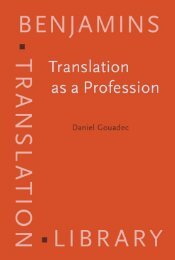Constructing a Sociology of Translation.pdf
Constructing a Sociology of Translation.pdf
Constructing a Sociology of Translation.pdf
- No tags were found...
Create successful ePaper yourself
Turn your PDF publications into a flip-book with our unique Google optimized e-Paper software.
178 Andrew ChestermanNorms, brief, strategiesWe can now ask more specifically how translation causality works, or, more specifically,how practice, discourse and habitus are manifested.<strong>Translation</strong> practice is crystallized in translation norms. Norms entered translationstudies primarily via Toury’s applications <strong>of</strong> Even-Zohar’s work on polysystems,but they are also central notions in sociology (see e.g. Giddens 1997). Asvalues, intersubjectively agreed and established, they are cultural phenomena. Butthey are manifested in observable social behaviour, including the activity <strong>of</strong> translating.As ideas, they exist in the cultural sphere (according to the way I framedthis sphere above, in contrast to the social one), but their prescriptive force, theircausal influence, is seen in social practices and in their products, including <strong>of</strong>course translations.The discourse conditions <strong>of</strong> a translation are manifested in the translationbrief, the client’s specification, the instructions. I take the brief to include thesource text, the skopos, the resources, deadline, fee, etc. – all the task conditionsrelevant to a given translation. The brief (presumably) affects the way the translatorthinks about a particular task, the way in which decisions are made during theprocess. Skopos theory has made the task specification a central notion, but muchremains to be discovered about the precise nature <strong>of</strong> the relation between givenfeatures <strong>of</strong> a specification, given features <strong>of</strong> the cognitive process <strong>of</strong> translating,and given features <strong>of</strong> the resulting translation. 2Simeoni (1998) motivates his re-examination <strong>of</strong> the translator’s habitus by theneed for a better conceptualization <strong>of</strong> the translator’s choices and the factors affectinga translator’s individual style (Simeoni 1998: 1). In addition to the habitus,the factors obviously include the translator’s competence, the translation’s skopos,the task conditions (time, resources, text type, the language pair concerned, etc.)and the wider translation tradition as a whole, within which the translator works.The decisions made as a result <strong>of</strong> the joint influence <strong>of</strong> these and other relevantfactors are manifested in the translator’s strategies, which lead to the use <strong>of</strong> particulartextual techniques, resulting in various kinds <strong>of</strong> equivalences and shifts. Inthis sense, strategies correspond to what some other scholars have called “globalstrategies” (Séguinot 1989), applying to the whole <strong>of</strong> a text or to a recurring kind<strong>of</strong> translation problem. Examples are decisions concerning foreignization or domestication;the use or avoidance <strong>of</strong> footnotes; general principles for dealing withvery long sentences or names or metaphors, in a given text-type; attitudes to theuse <strong>of</strong> loanwords; attitudes to norms; general principles regarding working meth-2. The question <strong>of</strong> how translations <strong>of</strong> the same source text vary when the specification variesis precisely the subject <strong>of</strong> Norberg (2003).
















